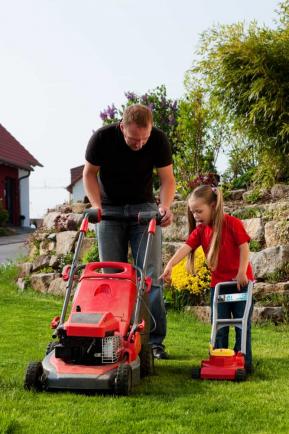
Children need to learn to work. With all of our modern conveniences, their opportunities to learn are becoming few and far between. Teaching your children to work in the yard will help them learn the value of work, give you valuable time together and make your lush, green lawn the talk of the neighborhood.
A beautiful lawn mainly depends on how it is maintained. Lawn care does not have to be a tough job. Basic lawn care involves proper watering, mowing and fertilizing.
Here are five lawn care tips to maintain a healthy lawn all year long
1. Know your soil
Soil is the key to a beautiful, green, lush lawn. Types of soil differ from yard to yard. Therefore, a soil test is very important in order to know the type of fertilizer you need for your lawn. You can use a soil test kit to know the levels of potassium, nitrogen and phosphorus. If you do not have a soil testing kit, you can get in touch with a cooperative extension service. They will conduct the soil test for a nominal fee. They will also help you regarding fertilizer applications.
2. Watering
Use water regularly on your lawn to keep it in good condition. Most lawns require about 2 1/2 inches of water every week in hot weather conditions. Cool conditions need less water. You can use a soil probe to check the root length of the grass under the ground and water accordingly. Deep lawn watering is recommended for growing deeper roots. Instead of watering every day, it is better to water your lawn every two-three days.
3. Fertilize
Consider using fertilizer in the growing season, especially in spring. Fertilize your lawn at the beginning of spring, late spring, also in the late summer and toward the end of the growing season. You might not need to use fertilizer in both early spring and at the end of the growing season, depending upon your grass quality. Grass needs nitrogen for growth. A fertilizer rich in nitrogen and designed for grass is a good choice.
4. Mow
Mow the lawn regularly at 1/3 of the blade length. Maintain the grass length between 2-3 inches tall. While mowing your lawn do not set the mower in a very low position as it can increase the number of weeds and removes the stored nutrients from leaf blades. Using a mulching lawnmower helps to speed up the mowing process. Cool climate grasses like rye grass, bluegrass, and fescues need to maintain a 2.5 to 3.5 inch height. Warm weather grasses, such as zoysia, Bermuda, St. Augustine, and centipede should have a 1.5 to 2.5 inch height.
5. Weed and Pest Control
Lots of annual weeds can take control of your lawn if they are allowed to germinate. Use pre-emergent weed control on lawns to prevent weeds from germinating and allow your lawn to flourish. Timing is very crucial. Pre-emergent weed control is not effective if used after the germination. Spring weeds such as clovers, dandelions, and plantains can be prevented by keeping a correct mowing height combined with correct fertilization. Winter diseases like snow mold or Bermuda dead spot can be quite harmful for a lawn. You need to take good care to prevent winter diseases. Proper application of fertilizer and lawn mowing are also important to prevent pests.
Use these simple tips to take good care of your lawn. Use this opportunity to teach proper lawn care to your children. You will grow a beautiful lawn and a beautiful relationship with your children.

